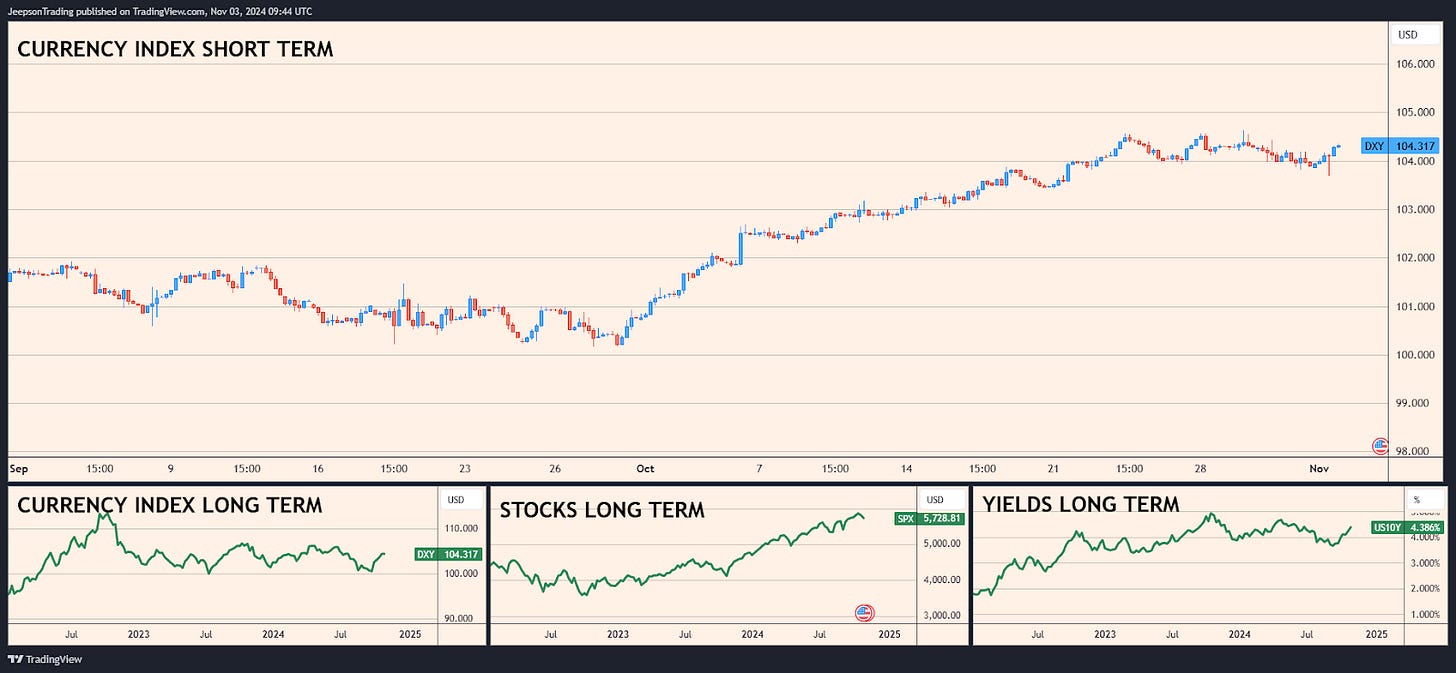Election Special: Analysing Dollar Outcomes
Sunday, November 3, 2024 (Week 44)
The dollar demonstrated exceptional strength through October, achieving its strongest monthly performance since 2022 with a 3% gain. Credit Agricole identifies two primary scenarios driving current FX market positioning: a potential Harris presidency with divided Congress that could yield policy gridlock, or a "red wave" delivering both presidency and Congress to Republicans, potentially unleashing substantial fiscal stimulus alongside aggressive trade measures.
Deutsche Bank's analysis suggests asymmetric dollar risks, with limited downside in a divided government scenario but significant upside potential under a Republican sweep. The bank projects dollar appreciation across all major currency pairs under a red sweep scenario, with carry trades particularly vulnerable in a Trump victory without congressional control.
Bullish Dollar Catalysts
The case for sustained dollar strength rests on several interconnected factors:
Electoral Momentum: Trump now leads in five of seven key swing states according to FiveThirtyEight averages as of October 31st:
Arizona (+2.2%, extending from +1.0% month prior)
Georgia (+1.8%, widening from +0.6%)
North Carolina (+1.1%, reversing from Harris +0.1%)
Pennsylvania (+0.4%, crucial swing from Harris +1.0%)
Georgia (+1.8%, up from +0.6%)
Policy Implications: Trump's proposed measures could drive structural dollar support:
Up to 60% tariffs on Chinese imports
Extension of 2017 tax cuts
"Made in America" 15% corporate tax rate
100% tariffs on Mexican auto imports
Economic Backdrop: Goldman Sachs projects higher near-term inflation under Trump policies, particularly citing auto import tariffs affecting core inflation metrics.
Bearish Considerations
ING highlights several factors that could weaken the dollar's position:
Electoral Uncertainty: Key state margins within 0.5% would trigger automatic recounts, with Pennsylvania's final results legally required by November 26th
Policy Implementation: Significant lag time between election and actual trade policy changes
Economic Impact: Goldman Sachs projects weaker GDP growth in 2025 under Trump's trade and immigration policies versus a Harris administration
Financial Markets
Equity Market Dynamics
Market positioning reflects evolving electoral probabilities while maintaining hedges against multiple outcomes. JPMorgan's analysis suggests limited broad market preference between candidates, noting Trump's populist rhetoric and tariff agenda have eroded traditional Republican advantages on financial issues.
Bond Market Implications
ING projects:
Republican Sweep: Potential 5% handle for 10-year yields amid aggressive fiscal expansion
Split Government: Moderate yield increases driven by inflation concerns
Democratic Victory: More contained yield movement reflecting tighter fiscal approach
Commodity Market Outlook
ING's commodity analysis presents distinct scenarios:
Republican Sweep: Near-term oil price support from tax cuts, longer-term pressure from domestic production focus
Split Government: Focus on foreign policy driving Middle East risk premium
Democratic Victory: Lower growth prospects weighing on near-term demand, more moderate long-term price trajectory
Economic Framework
Growth Dynamics
Goldman Sachs provides contrasting growth scenarios:
Harris Administration: Stronger job growth and GDP expansion through 2026
Trump Administration: Near-term output contraction from trade and immigration policies
Inflation Trajectory
Core inflation developments warrant particular attention given candidate policy divergence:
Trump Policies: Upward pressure from tariffs and fiscal stimulus
Harris Approach: More moderate inflation profile enabling greater Fed flexibility
Monetary Policy Integration
The Federal Reserve faces distinct challenges under different electoral outcomes:
Republican Sweep: Reduced flexibility given inflationary policy mix
Split Government: More traditional policy transmission mechanics
Democratic Sweep: Greater latitude for conventional monetary policy
Currency Market Implications
Credit Agricole emphasises asymmetric dollar risks:
Limited downside under divided government
Substantial upside potential in Republican sweep scenario
Particular vulnerability for China-exposed currencies under Trump trade policies
Conclusion
The dollar's path through year-end appears increasingly contingent on both electoral outcomes and subsequent policy implementation timelines. Pennsylvania's results, potentially not finalised until November 27th, may prove decisive for both political and market trajectories.
Key Action Points:
Monitor Pennsylvania results given 0.5% recount trigger threshold
Track congressional outcomes for fiscal policy implications
Assess tariff implementation timeline under Trump victory scenario
Risk Considerations:
Extended result uncertainty in key swing states
Policy implementation gaps between election and inauguration
Market positioning adjustment to confirmed outcomes
Sources:
FiveThirtyEight Election Data
Polymarket Betting Odds (October 31st)
Credit Agricole FX Analysis
Deutsche Bank Currency Projections
ING Market Scenarios
Goldman Sachs Economic Forecasts
JPMorgan Market Strategy



